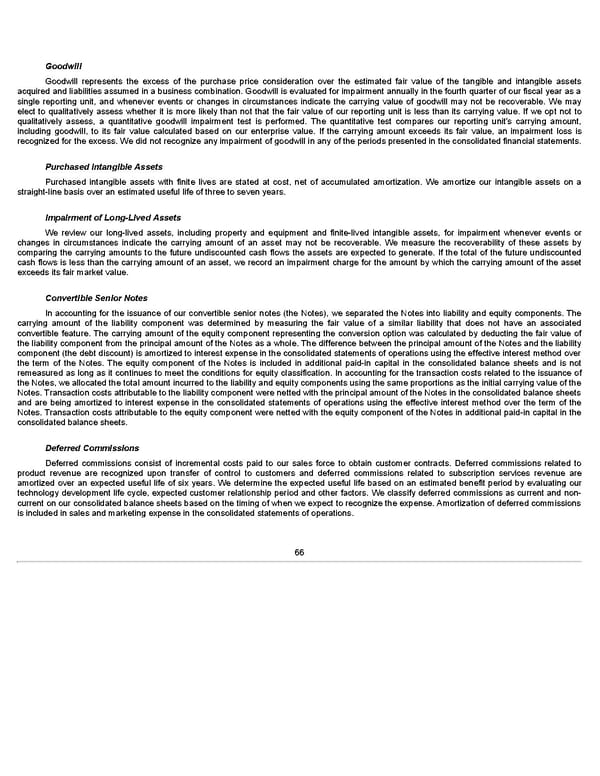Goodwill Goodwill represents the excess of the purchase price consideration over the estimated fair value of the tangible and intangible assets acquired and liabilities assumed in a business combination. Goodwill is evaluated for impairment annually in the fourth quarter of our fiscal year as a single reporting unit, and whenever events or changes in circumstances indicate the carrying value of goodwill may not be recoverable. We may elect to qualitatively assess whether it is more likely than not that the fair value of our reporting unit is less than its carrying value. If we opt not to qualitatively assess, a quantitative goodwill impairment test is performed. The quantitative test compares our reporting unit's carrying amount, including goodwill, to its fair value calculated based on our enterprise value. If the carrying amount exceeds its fair value, an impairment loss is recognized for the excess. We did not recognize any impairment of goodwill in any of the periods presented in the consolidated financial statements. Purchased Intangible Assets Purchased intangible assets with finite lives are stated at cost, net of accumulated amortization. We amortize our intangible assets on a straight-line basis over an estimated useful life of three to seven years. Impairment of Long-Lived Assets We review our long-lived assets, including property and equipment and finite-lived intangible assets, for impairment whenever events or changes in circumstances indicate the carrying amount of an asset may not be recoverable. We measure the recoverability of these assets by comparing the carrying amounts to the future undiscounted cash flows the assets are expected to generate. If the total of the future undiscounted cash flows is less than the carrying amount of an asset, we record an impairment charge for the amount by which the carrying amount of the asset exceeds its fair market value. Convertible Senior Notes In accounting for the issuance of our convertible senior notes (the Notes), we separated the Notes into liability and equity components. The carrying amount of the liability component was determined by measuring the fair value of a similar liability that does not have an associated convertible feature. The carrying amount of the equity component representing the conversion option was calculated by deducting the fair value of the liability component from the principal amount of the Notes as a whole. The difference between the principal amount of the Notes and the liability component (the debt discount) is amortized to interest expense in the consolidated statements of operations using the effective interest method over the term of the Notes. The equity component of the Notes is included in additional paid-in capital in the consolidated balance sheets and is not remeasured as long as it continues to meet the conditions for equity classification. In accounting for the transaction costs related to the issuance of the Notes, we allocated the total amount incurred to the liability and equity components using the same proportions as the initial carrying value of the Notes. Transaction costs attributable to the liability component were netted with the principal amount of the Notes in the consolidated balance sheets and are being amortized to interest expense in the consolidated statements of operations using the effective interest method over the term of the Notes. Transaction costs attributable to the equity component were netted with the equity component of the Notes in additional paid-in capital in the consolidated balance sheets. Deferred Commissions Deferred commissions consist of incremental costs paid to our sales force to obtain customer contracts. Deferred commissions related to product revenue are recognized upon transfer of control to customers and deferred commissions related to subscription services revenue are amortized over an expected useful life of six years. We determine the expected useful life based on an estimated benefit period by evaluating our technology development life cycle, expected customer relationship period and other factors. We classify deferred commissions as current and non- current on our consolidated balance sheets based on the timing of when we expect to recognize the expense. Amortization of deferred commissions is included in sales and marketing expense in the consolidated statements of operations. 66
 Annua lReport Page 65 Page 67
Annua lReport Page 65 Page 67